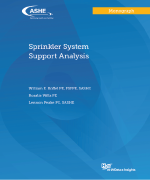Sprinkler System Support Analysis

by William E. Koffel PE, FSFPE, SASHE, Rosalie Wills PE and Lennon Peake PE, SASHE
Health care organizations across the country have spent substantial time and effort to comply with National Fire Protection Agency (NFPA) requirements related to non-sprinkler system components supported by and/or touching sprinkler piping/hangers.
In order to address the issue, the American Society for Health Care Engineering (ASHE) and Koffel Associates performed a study to investigate the hazards posed by non-sprinkler system components being supported by and/or touching sprinkler pipes. This study included a literature review of the history of the NFPA 13 and NFPA 25, addressing the Technical Committees’ substantiation for the requirements. The concern is that the added weight of the components and corrosion risk that the components present could affect the performance and life of a pipe.
Ten surveys of different existing health care facilities were conducted to determine the typical items supported by and/or touching sprinkler piping. Within these 10 facilities, a total of 1,262 findings of non-sprinkler system components touching and/or being supported by sprinkler piping were found.
| Access PDF | Members can download a PDF of the entire monograph. |
| Order print version | Catalog number: 055916 Member: $25.00, Nonmember: $35.00
|
